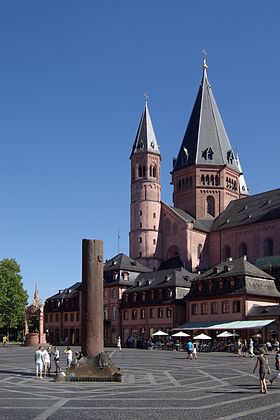Ecclesiastical province Freiburg Area 7,692 km² | Denomination Roman Catholic Established 4th Century Auxiliary bishop Udo Bentz | |
 | ||
Metropolitan Archdiocese of Freiburg Population- Total- Catholics (as of 2013)2,886,854754,441 (26.1%) Emeritus bishops Karl Lehmann, Franziskus Eisenbach | ||
The Diocese of Mainz is a diocese of the Catholic church in Germany, historically known in English by its French name of Mayence. It was created in 1802 with the abolition of the old Archbishopric of Mainz. The diocese is suffragan to the Archdiocese of Freiburg. Its district is located in the states of Rhineland-Palatinate and Hesse. The seat of the diocese is in Mainz at the Cathedral dedicated to Saints Martin and Stephen. It is the only Roman Catholic diocese in the world which bears the title of a Holy See next to Rome.
Contents
Bishop and cathedral chapter
Under Article 14 of the Reichskonkordat of 1933, which remains in force, the determination of the bishop to head the episcopal see and the composition of the chapter are governed by the provisions of Baden Concordat of 1932.
The Roman Catholic Diocese of Mainz comprises an area of 7692 square kilometers. It is divided into 20 deaneries, which in turn are divided into 136 pastoral care units. This parish associations or parish groups include all 335 parishes and other chaplaincies of the diocese (as of 2007). Pastoral units on the parish level have been introduced as a result of a profound structural change in the Catholic Church in Germany in many dioceses, the constitution of these units was determined by particular law [law of a particular region or territory], i.e., allowing for differences from one diocese to another. In the diocese of Mainz a parish group may be several parishes merged under the leadership of a single pastor. The parishes retain their church and state church legal personality. The pastor is attached to a pastoral team and a pastoral council. Parish associations, however, are combinations of several parishes, each with its own pastor. Several parish groups can join together to form a parochial associations.
Bishops of Mainz, 1802-present
Diocese (1802-present)
Catholic Private Schools
The most important educational institution of the Diocese is the Catholic University of Applied Sciences, Mainz. Besides the Roman Catholic Diocese of Mainz and the (arch)dioceses of Cologne, Limburg, Speyer and Trier belong to the initiators of this university . There are also other schools as the Edith-Stein-Schule in Darmstadt, Liebfrauenschule in Bensheim, the Episcopal Willigis-Gymnasium in Mainz, Abendgymnasium Ketteler of Mainz and the Episcopal College Willigis secondary school in Mainz.
Facilities at state universities
The diocese maintains three facilities at state universities. The most important of them is the Catholic Theological Faculty at the University of Mainz. In addition, there are at University of Giessen, the Institute for Catholic theology and their didactics, which is located at the Department of History and Cultural Studies. At the Technische Universität Darmstadt is an institute for theology and social ethics.
Bildungswerk der Diözese Mainz
The Bildungswerk der Diözese Mainz (educational works of the diocese of Mainz) promotes "... the church's adult education in the diocese from the parish to the diocesan level ..." The Bildungswerk is also a member of the Catholic Adult Education Hesse - Regional Working Group.
Other educational institutions
Cathedral and Major basilicas
Other well-known churches
Perpetual liturgical calendar
Internal feasts of the diocese are:
